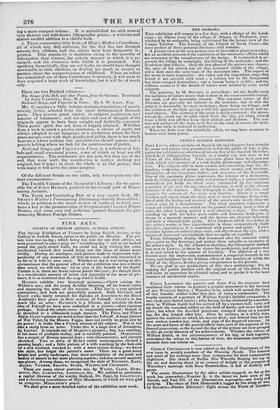LEWIS'S SPANISH SKETCHES.
JOHN LEWIS, whose pictures of Spanish life and character have brought his name and talents very prominently before the public of late, is pre- paring for publication a selection of twenty-five of his Spanish Sketches, which he is lithographing himself, in a similar size and style to his Views of the Alhambra. Two specimen plates have been just put forth, which give promise of a work highly picturesque and character- istic. The subjects will be more various and interesting than the Al- hambra ; consisting of groups of figures, street scenes, and interiors, illustrative of the characters, habits, and costumes of the Spaniards. One of the specimen plates represents the interior of a monastery, with its richly-carved wainscoting and pictured walls,--a palace where monachism yet holds its silent state, surrounded by the gorgeous pageantry of art and the treasures of learning, as well as the grosser luxuries of the kitchen. The lithograph is rich and effective, and suggests the colours of the scene very forcibly. There is a rough freedom and vigour about the style, that is more welcome, being com- bined with the feeling and mastery of the artist's own touch, than the neatest copy by a draughtsman. The other specimen represents a couple of muleteers, one seated on the groand drinking from a skin of wine, the other leaning against a well smoking a cigar. The mule, standing by with his laden pack-saddle and fantastic bead-gear, is drawn in a masterly manner ; and the figures are cleverly indicated, and form a characteristic group. That hardness which is a defect in this artist's works is less objectionable in these comparatively slight sketches, especially as it is combined with power and spirit. Lewis sketches figures on rather a large scale, and objects near the eye, with a degree of force and verisimilitude that we rarely see equalled. These lithographs display that command over the material which gives point to the drawings, and makes them valuable as examples of the artist's style. In the Alhambra sketches, the lithographic method was new to LEWIS; in these he shows his proficiency, and proves that it is well suited to his manner of handling. The addition of a tint thrown over the impression, communicates a congenial warmth to the scene, and heightens by the brilliant effect of the touches of white the relief of the objects, besides giving completeness to the picture.
We are glad to see productions of this class multiplying : for, by making the public familiar with the original work of the artist, they will learn to appreciate its pictorial value, and to prefer it to the tame neatness of mechanical copies.


























 Previous page
Previous page